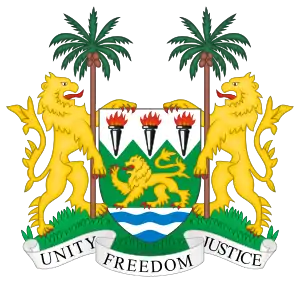Sierra Leone (1961–1971)
Sierra Leone was a sovereign state with Queen Elizabeth II as its head of state between independence on 27 April 1961 and becoming the Republic of Sierra Leone on 19 April 1971.[3]
Sierra Leone | |||||||||
|---|---|---|---|---|---|---|---|---|---|
| 1961–1971 | |||||||||
Motto: Unity, Freedom, Justice | |||||||||
 | |||||||||
| Capital | Freetown | ||||||||
| Government | Constitutional monarchy | ||||||||
| Queen | |||||||||
• 1961–1971 | Elizabeth II | ||||||||
| Governor-General | |||||||||
• 1961–1971 | See list | ||||||||
| Prime Minister | |||||||||
• 1961–1971 | See list | ||||||||
| Historical era | Decolonisation of Africa | ||||||||
• Independence | 27 April 1961 | ||||||||
• Republic | 19 April 1971 | ||||||||
| Population | |||||||||
• 1963 | 2,180,355[1] | ||||||||
• 1965 | 2,473,294[2] | ||||||||
• 1970 | 2,692,259[2] | ||||||||
| Currency | British West African pound (until 1964) Leone (after 1964) | ||||||||
| |||||||||
| Today part of | Sierra Leone | ||||||||
When British rule ended in April 1961, the British Crown Colony of Sierra Leone was given independence under the Sierra Leone Independence Act 1961.[4] Elizabeth II, remained the head of state of Sierra Leone[5] and was represented in Sierra Leone by a Governor-General.[6] Sierra Leone shared the Sovereign with other countries, including the United Kingdom.
History
On 27 April 1961 Sierra Leone gained independence.[7]
In 1962 general elections were won by the Sierra Leone People's Party (SLPP). The All People's Congress (APC) emerged as the most organised opposition.[7]
In March 1964 Njala University opened. On April 28 1964 Prime Minister Milton Margai died. His brother, Albert Margai, was appointed as new prime minister. On August 4 1964 Sierra Leone currency, the Sierra Leonean leone, was established.[8]
In 1967 general elections were held in Sierra Leone. The APC won by a narrow margin. Brigadier John Lansana, head of the military, seized control of government immediately after swearing in of the new APC prime minister, Siaka Stevens. Lansana was ousted a few days later by junior military officers who invite Andrew Juxon-Smith, a senior officer on leave, to return and head a provisional government, the National Reformation Council (NRC).[8]
In 1968 NRC was overthrown by warrant officers of the army. John Bangura, a formerly dismissed senior officer, invited to head the army. Bangura turned over government to the APC, led by Siaka Stevens.[8]
In 1969 University of Sierra Leone was set up, comprising Fourah Bay College and Njala University.[8]
On 19 April 1971 Sierra Leone became a republic with Siaka Stevens as executive president.[8]
Governors-General
The Governors-General of Sierra Leone were:[3]
- Sir Maurice Henry Dorman (27 April 1961 – 27 April 1962)
- Sir Henry Josiah Lightfoot Boston (27 April 1962 – April 1967)
- Andrew Juxon-Smith (April 1967 – 18 April 1968) (acting)
- John Amadu Bangura (18–22 April 1968) (acting)
- Sir Banja Tejan-Sie (22 April 1968 – 31 March 1971)
- Christopher Okoro Cole (31 March – 19 April 1971) (interim)
Prime Ministers
The Prime Ministers (and heads of government) of Sierra Leone during this period were:[3]
- Milton Margai (27 April 1961 – 30 April 1964)
- Albert Margai (30 April 1964 – 17 March 1967)
- Siaka Stevens (first term) (17 March 1967 – 21 March 1967)
- David Lansana (21 March 1967 – 24 March 1967)
- Ambrose Patrick Genda (24 March 1967 – 27 March 1967)a
- Andrew Juxon Smith (27 March 1967 – 19 April 1968)a
- Patrick Conteh (19 April 1968 – 26 April 1968)b
- Siaka Stevens (second term) (26 April 1968 – 19 April 1971)
a. As Chairman of the National Reform Council.
b. As Chairman of the National Interim Council.
Transition to a Republic
.svg.png.webp)
Elizabeth II visited Sierra Leone from 25 November to 1 December 1961, shortly after independence.[9]
Sierra Leone became a republic within the Commonwealth on the promulgation of the 1971 constitution and Prime Minister Siaka Stevens became the first President of Sierra Leone.[10]
References
Bibliography
- Kargbo, Michael S. (2006). British Foreign Policy and the Conflict in Sierra Leone, 1991–2001. Google Books. Peter Lang. p. 70. Retrieved 19 November 2017.
- Fyle, Magbaily C. (2006). Historical Dictionary of Sierra Leone. Lanham, Maryland: Scarecrow Press. pp. XVII–XXII. ISBN 978-0-8108-5339-3.
Notes
- "FINAL RESULTS 2004 POPULATION AND HOUSING CENSUS" (PDF). Sierra-leone.org. Retrieved 15 August 2018.
- "Sierra Leone Population". Worldometers. Retrieved 3 January 2018.
- "Sierra Leone". WorldStatesmen.org. Retrieved 19 November 2017.
- "Sierra Leone Independence Act 1961". Legislation.gov.uk. Retrieved 19 November 2017.
- "Sierra Leone Heads". Worldwide Guide to Women in Leadership. Retrieved 20 November 2017.
- Kargbo 2006, p. 70.
- Fyle 2006, p. XXII.
- Fyle 2006, p. XXIII.
- "Commonwealth Tours: 1960s". British Pathé. Retrieved 20 November 2017.
- "Sierra Leone". The Commonwealth. Retrieved 20 November 2017.
External links
- "SIERRA LEONE INDEPENDENCE BILL (Hansard, 27 March 1961)". Hansard.millbanksystems.com. Retrieved 26 January 2017.
- "SIERRA LEONE (GIFT OF A MACE) (Hansard, 30 January 1962)". Hansard.millbanksystems.com. Retrieved 26 January 2017.
- "Orders of the Day — Sierra Leone Independence Bill: 22 Mar 1961: House of Commons debates". TheyWorkForYou. Retrieved 26 January 2017.

